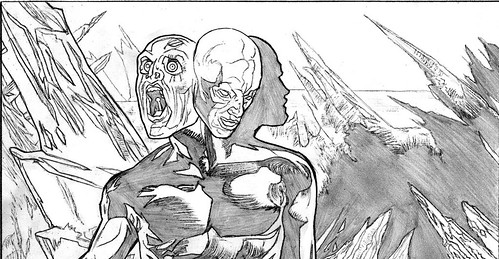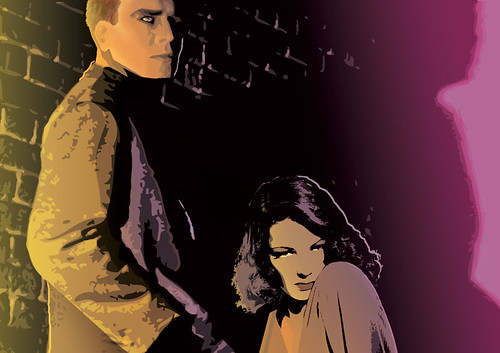Continuing The True and Terrible History of SHADRACH STONE, the Graphic Novel...

While I was developing SHADRACH, Axel Alonso at Marvel had shown me Jon Proctor’s work. Jon and I almost did a Wolverine story together, but not quite. Jon was working away on a book called The Black Diamond with Larry Young, and I was struck by his sharp, design-oriented layouts and gorgeous color sense -- some of the best color work in the business, I think. Jon and I met briefly at the San Diego Comicon in ’06 at Larry’s booth, and talked about pitching something together to the new Marvel Comics Presents title.
In subsequent emails, we got talking about different kinds of comics, and I mentioned I had a few Marvel ideas and one original one. Jon replied, “I'm interested to hear about the less Marvel-y project.”
Poor bastard.

Jon loved SHADRACH. He jumped on the idea and started producing sketches and sample pieces. Meanwhile, I set about converting the script from teleplay to a comics script. This is a much trickier process than it sounds; despite appearances, the two media are very, very different. Comics is all about compression, and about isolated images that add up to form a story. Screenplays and teleplays unfold at a more natural, less staccato pace; it’s much easier to convey a range of actions (Adam walks to the door, grasps the knob, looks around furtively, grimaces, and pulls it open). A lot of the action had to be reblocked, and the dialogue had to be trimmed and refocused.
But I know comics better than I know teleplays -- and there are things comics do better than any other medium. Captioning, for instance, is a powerful tool that can provide an off-kilter perspective, or even an entirely parallel narrative, to the story unfolding in the panels. The same effect can be achieved on film using voice-over, but it’s tougher to pull off. It often seems forced.
And I realized I could add another level to the story: a series of mythological images accompanied by narrative captions that would introduce each chapter, recur at odd times, and then pay off at the end. That sounds pretentious and confusing, but it’s really a simple technique. And it doesn’t interfere with the main story, which is a very linear narrative of Shadrach's odyssey.

While I was noodling around pretentiously with the sequential art form, Jon pumped out some beautiful preliminary pencilled pieces...like the shot below, showing early versions of Shadrach and his girlfriend Vida. We started feeding off each other’s ideas, the way the best comics collaborations often work.

We were off and rolling…somewhere. But where?
Find out in part three...


No comments:
Post a Comment